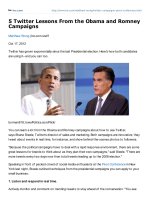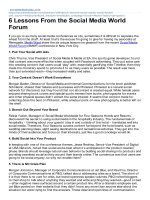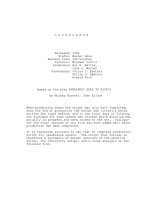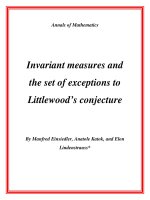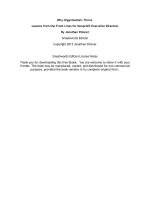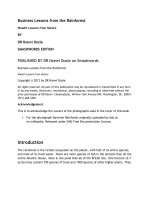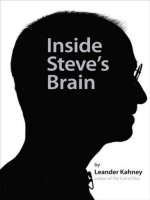Bierman beating the bear; lessons from the 1929 crash applied to today’s world (2010)
Bạn đang xem bản rút gọn của tài liệu. Xem và tải ngay bản đầy đủ của tài liệu tại đây (1.96 MB, 225 trang )
BEATING THE BEAR
Lessons from the 1929 Crash
Applied to Today’s World
Harold Bierman, Jr.
Beating the Bear
BEATING THE BEAR
Lessons from the 1929 Crash
Applied to Today’s World
Harold Bierman, Jr.
Copyright 2010 by Harold Bierman, Jr.
All rights reserved. No part of this publication may be reproduced, stored in a retrieval
system, or transmitted, in any form or by any means, electronic, mechanical,
photocopying, recording, or otherwise, except for the inclusion of brief quotations in
a review, without prior permission in writing from the publisher.
Library of Congress Cataloging-in-Publication Data
Bierman, Harold.
Beating the bear : lessons from the 1929 crash applied to todayÊs world / Harold
Bierman, Jr.
p. cm.
Includes bibliographical references and index.
ISBN 978-0-313-38214-7 (alk. paper) · ISBN 978-0-313-38215-4 (ebook)
1. Stock Market Crash, 1929. 2. Global Financial Crisis, 2008–2009 3. Bear
markets·History. 4. Investments. I. Title.
HB37171929.B387 2010
330.973'0916·dc22
2010014496
ISBN: 978-0-313-38214-7
EISBN: 978-0-313-38215-4
14
13
12
11
10
1
2
3
4
5
This book is also available on the World Wide Web as an eBook.
Visit www.abc-clio.com for details.
Praeger
An Imprint of ABC-CLIO, LLC
ABC-CLIO, LLC
130 Cremona Drive, P.O. Box 1911
Santa Barbara, California 93116-1911
This book is printed on acid-free paper
Manufactured in the United States of America
I still think keeping that memory green a useful service,
if only for the minority so saved.
John Kenneth Galbraith
CONTENTS
Acknowledgments
ix
Introduction
xi
1. How High Is High? The Stock Markets in 1929 and 2008
1
2. The Events Prior to the 1929 and 2008 Crashes
9
3. Market Myths in 1929 and 2008–2009
19
4. The FedÊs Role in Good Times and Bad
29
5. Practice for the October Crash: The Week of
March 25, 1929
55
6. The 1929 Market in Depth: The Ups and Downs
of the 1929 Stock Market
63
7. The Great Crash of 2008: The 2008–2009 Market in Depth
77
8. Stopping the Speculators: Margin Buying, Pools, Trusts,
Short Selling, and the 1929 Crash
95
9. The Senate Hearings of 1931 Concerning 1929
109
10. Dispelling the Myths of 1929
115
11. The U.S. Government Accuses . . .
141
12. The Prime Cause of the 1929 Crash: The Public
Utility Sector
153
viii
CONTENTS
13. Lessons to Be Learned
167
14. Post-Crash Investment Strategies:
Beating the Bear Market
179
Notes
185
Bibliography
193
Index
199
ACKNOWLEDGMENTS
Many people contributed to this project. Among those who were especially
helpful were: Betsy Ann Olive and Don Schedeker of CornellÊs Johnson
Graduate School of ManagementÊs library staff; Rosemary A. Lazenby of
the archives division of the Federal Reserve Bank of New York; Seymour
Smidt, Jerome Hass, and Maureen OÊHara, faculty colleagues at Cornell
made useful suggestions. Barb Drake typed untold revisions. Dick Conway called my attention to the article that motivated my initial research
efforts.
Sections of this book were written during a study leave spent at the
Judge Institute of Management, University of Cambridge. The leave and
the research were financed by the Arthur Andersen Foundation and CornellÊs Johnson Graduate School of Management. Richard Barker, Sandra
Dawson, Gishan Dissanaike, Geoff Meeks, Christopher Pratt, and Geoff
Wittington all facilitated my visit and made it a very pleasant experience.
At Cornell, Sheri Hastings kept my faxes flowing. Above all, I want to
thank the people at the University of Cambridge Library, especially Ann
Toseland; Ann kept me supplied with film of the newspapers of 1929 to
1950, and did not complain of my repetitive requests. While the others are
unnamed by me (unfortunately), their helpfulness is well remembered.
I also want to thank Burton Malkiel, who offered a friendly intellectual
challenge that led to my initial interest in the events of 1929.
INTRODUCTION
Senator Glass: „Mr. Whitney, right on that point may I ask you
a question: What percentage of the public is [sic] speculating in
stocks of the stock exchange understand the real intrinsic value
of the stocks in which they deal?‰
Hearings before the U.S. Senate Committee on Banking and
Currency on stock exchange practices
Admittedly, it is preposterous to suggest that stock speculation
is like coin flipping. I know that there is more skill to stock
speculation. What I have never been able to determine is·how
much more?
·Fred Schwed, Jr., Where Are the CustomersÊ Yachts?
The year 1929 stands out as the most significant year of the decade of
the 1920s. In the minds of most people, the year 1929 marks the crash
of the stock market, the beginning of the Great Depression, and the end
of a 10-year period of prosperity that exceeded anything the United States
had ever known.
In 1955, John Kenneth Galbraith published his very readable and enjoyable classic The Great Crash, 1929. A reader of that popular book might
well conclude that it would be foolhardy for someone to retrace the same
path. And it would be; but I will follow a different path and arrive at a
different set of conclusions.
xii
INTRODUCTION
What actually was the economic situation in 1929? How does it compare
to the economic situation in 2008 – 2009? To better illuminate the current
dark financial picture, I take a fresh look at the Crash of 1929 and then
compare that period to the stock crash of 2008 – 2009. I challenge the facts
„everyone knows‰ and overturn previously held assumptions concerning
the catastrophic events that led to 10 years of economic depression. Likewise, todayÊs news is filled with stories about what is happening and
why. While itÊs still too soon to come to rock-solid conclusions about the
financial market meltdown of 2008 – 2009, much of what has happened
could have been foreseen and even avoided · just as it could have been
in 1929. By accurately assessing the causes behind the 1929 stock market
crash that led to the Great Depression, and the causes that led to the decline
of 2008 – 2009, readers can better grasp the present market situation and
more wisely make financial decisions.
This book considers the economic situation in 1929 and the events leading up to the stock price declines in October of that year. It concludes that
the 1920s were a wondrous period of economic prosperity for the United
States, and that in 1929 it was far from obvious that the stock market was
in trouble. But something very serious happened in 1929 to stock prices,
and we should try to understand it.
There are many myths about 1929 that are incorrect. The myth that
is most relevant to this book is „Stocks were obviously overpriced (the
evidence suggests stocks were reasonably priced.)‰ While stocks were not
obviously overpriced in general, there was one sector of the market, public
utilities, that can be shown to have been overpriced.
This book is an attempt to refute unjustified myths and to define the
causes of the 1929 stock market crash. There were several factors that
combined in October 1929 to bring about the crash.
It is important that the causes be properly understood, because the 1929
stock market was not that much different from the market today or different
from what the market could be at any time in the future.
The 2008 – 2009 stock market crash was actually more severe than the
1929 – 1930 crash, and it is equally important to understand that event.
During the 1920s, commerce in the United States attracted truly
outstanding individuals who achieved successes of an international nature.
The stories and achievements of such business people as Benjamin Strong,
Owen D. Young, and Alfred P. Sloan are inspirational. What went wrong
and caused the stock market to crash in October 1929?
What did happen in 1929? Herbert Hoover, the president of the United
States, saw increasing stock market prices as a speculative bubble manufactured by the mistakes of the Federal Reserve Board: „One of these
clouds was an American wave of optimism, born of continued progress
INTRODUCTION
xiii
over the decade, which the Federal Reserve Board transformed into the
stock-exchange Mississipi Bubble.‰1 But the optimism was justified.
The „bubble‰ did not have to burst. The Federal Reserve Board did not
create the bubble, but it may have contributed to the destruction of stock
market values.
During 1928, in hearings before the Senate Committee on Banking and
Currency, Senator Glass asked Whitney to reveal the percentage of investors who were speculators and who understood the real intrinsic value of
the stocks they bought. Whitney (and others) could not distinguish between
a speculator and an investor. Also, no one in 1929 knew how to determine,
with any degree of confidence, the real intrinsic value of stocks (in fact,
the determination of stock value still remains a challenge). Stock picking
requires more skill than coin flipping, as Fred Schwed maintains, but it
is not clear how much more skill we have to pick stocks or to determine
when the market is too high (when it becomes necessary to make the sell
decision) or too low (when it becomes necessary to make the buy decision). Overconfidence on the part of investors who „know‰ that the market
is too high or too low is very dangerous, as the following conversation
suggests:
Investor: „I am developing a feel for the market.‰
Friend: „Take an aspirin. You are probably just catching a cold.‰
Many financial decisions made today are heavily influenced by what
we understand to have happened in the past. It is important that we try
to understand what the actual economic situation was in 1929 and what
happened to the stock market.
In 2008, the stock market again crashed. The 2008–2009 crash was
actually more severe than the 1929–1930 crash. We should look to the
events of 1929 in order to better understand the events of 2008–2009. The
first lesson for an investor is that even in a normal year, the stock market
can fall 50 percent in a matter of months. The investor who does not
recognize that fact is vulnerable to unnecessarily large losses. The stock
market is volatile and always will be. Diversify!
Chapter 1
HOW HIGH IS HIGH? THE STOCK
MARKETS IN 1929 AND 2008
However, contemporary and historical accounts have failed to
find even a smoking gun, let alone a culprit.
·Rappoport and White (1993, p. 570)
On Black Thursday, October 24, 1929, the stock market (New York Stock
Exchange) fell 34 points, a 9 percent drop for the day. The trading volume
was approximately three times the normal daily volume for the first nine
months of the year. There was a selling panic. But the series of events
leading to the crash actually started before that date.
THE STOCK MARKET 1922–1932
Table 1.1 shows the average of the highs and lows of the Dow Jones
Industrial Stock Index for 1922 to 1932.
Using the information of Table 1.1, from 1922 to 1929 stocks rose in
value by 218.7 percent. This is equivalent to an 18 percent annual growth
rate in value for the seven years. From the low of 245.6 in 1928 to the high
of 386 in 1929, there was a 57 percent growth; but using the 290.0 measure for 1929, the increase for 1929 was only 15 percent. From 1929 to
1932, stocks lost 73 percent of their value (different indices measured
at different times would give different measures of the increases and
decreases). The price increases were large but not beyond comprehension, given the real prosperity taking place in the United States. The price
decreases from 1929 to 1932 were consistent with the fact that by 1932,
2
BEATING THE BEAR
Table 1.1
Dow-Jones Industrials Index,* Average of
the Highs and Lows
Index
1922
91.0
1923
95.6
1924
104.4
1925
137.2
1926
150.9
1927
177.6
1928
245.6
1929
290.0
1930
225.8
1931
134.1
1932
79.4
*1922 –1929 measures are from the Stock Market
Study, U.S. Senate, 1955, pp. 40, 49, 110, and 111.
1930 –1932 average of the lows and highs for the
years, Wigmore, 1985, pp. 637–39.
there was a worldwide depression, and stock price expectations were not
optimistic.
If we take the 386 high of September 1929 and the 1929 year-end value of
248.48, the market lost 36 percent of its value during that four-month period.
John Kenneth Galbraith apparently would have had no difficulty forecasting
the crash: „On the first of January of 1929, as a matter of probability, it was
most likely that the boom would end before the year was out‰ (1961, p. 29).
Paul A. Samuelson, on the other hand, admits that „playing as I often do the
experiment of studying price profiles with their dates concealed, I discovered
that I would have been caught by the 1929 debacle‰ (1979, p. 9).
Most of us, if we held stock in September 1929, would not have sold early
in October. In fact, if I had liquidity, I would have purchased stocks after the
major break on Black Thursday, October 24. For the next 10 years, I would
have been sorry, since Black Thursday was not the end of the decline.
The 1929 stock market, for many reasons, was like a large boulder on
top of a hill. Given enough pushes to get it started, the boulder would roll
down the hill, accelerating as it went. We want to consider why the market
was in such a sensitive position and what factors acted to start its downward fall. We will find that there were many contributing factors leading
up to the crash. Each of them is small taken individually, but together they
helped create the right situation for the debacle.
HOW HIGH IS HIGH?
3
Observers were not pleased with the severity of the crash. Thus John
Maynard Keynes (Moggridge 1981, p. 1, and 1992, p. 480), in a letter
to his wife, Lydia (October 25, 1929), wrote, „Wall Street did have a go
yesterday . . . The biggest crash ever recorded . . . I have been in a thoroughly financial and disgusting state of mind all day.‰ Before the events
played out, many others would share KeynesÊs despondency.
There is evidence that the stone on the hill is an apt description of the
market in 1929. In a recent study, Rappoport and White (1994) treat brokersÊ
loans as options written by the lender and bought by the borrowers. They
conclude ( p. 271), „The sharp rise in implied volatility coincident with
the stock-market boom suggests the fear of a crash.‰ This conclusion, that
there was fear of a market crash, is easily acceptable given the statements
and positions of the Federal Reserve Board and the U.S. Senate, to be
described later.
One position is that the stock market was too high; thus a crash was
inevitable. Reasons will be given to justify the level of prices. I conclude
that the market was not too high in 1929.
There are two basic but naïve and incorrect methods of „proving‰ that the
stock market was too high in September–October 1929, using only stock
prices. One is to compare the stock market prices for some prior period,
say 1925, with those of September 1929. The stock price increases for this
time period are impressive. Balke and Gordon (1986) show a 155 percent
increase (the third-quarter 1929 stock prices are 2.55 times as large as the
1925 prices). During the first nine months of 1929, the increase was 15 percent. The market did go up dramatically from 1925 to October 1929.
The second popular method of „proving‰ that the market was too high
is to compare the September 1929 prices with those in November 1929 or,
more impressively, with prices in 1932. In 1932, prices were 32 percent of
the year-end 1929 prices. They went down. Malkiel (1996, p. 50) uses the
following stock prices (Table 1.2) to illustrate the excessive heights that
stocks reached in September 1929.
Obviously, either the September prices are too high, the November
prices are too low, or the world changed. But comparing stock prices
merely shows that changes took place. There is a plausible explanation for
the high prices of September 3, 1929.
In evaluating the P/EÊs of firms in 1929, it is useful to estimate the costs of
capital. Long-term debt was yielding approximately 5 percent and preferred
stock 6 percent. Dividend yield on the average stock was 3.19 percent in
August, and the dividend payout rate was 0.64. For comparison, U.S. Treasuries in August of 1929 yielded 3.7 percent.
With a retention rate of b = 0.36 and a return on new investment of
r = 0.14, the expected growth rate is g = rb = 0.14(.36) = 0.05. Assume that
4
BEATING THE BEAR
Table 1.2
Selected Stock Prices in 1929
High Price
September 3, 1929
Low Price
November 12, 1929
American Telephone &
Telegraph
304
1971Î4¼
Bethlehem Steel
140
781Î4¼
General Electric
3931Î4¼
7
1681Î8
Montgomery Ward
137 Î8
491Î4¼
National Cash Register
1271Î2
59
Radio Corporation of
America
101
28
the cost of equity is approximately 8.2 percent. With these assumptions
and facts, a P/ E of 20 is justified for the average firm.
P (1 − b )
0.64
=
= 20
=
E k − g 0.082 − 0.05
With a growth rate of 0.06, a P/ E of 29 would be justified.
Adding growth from the use of debt and from issuing new equity
capital, a larger P/ E than 20 would be justified. There is a wide range
of calculations of actual average P/ EÊs for 1929. One estimate in Bierman (1991, p. 59, based on statistics from MoodyÊs) is an average
P/ E of 16.3, which is low compared with the 20 computed above.
Wigmore (1985, p. 572) found a P/ E of 29.8 using the high stock prices
and 12.4 using the low prices of 1929. These P/ EÊs are based on the data
of 135 companies. Irving Fisher estimated the P/ E ratio to be 13 for
the market as of August 1929 (Commercial and Financial Chronicle,
October 26, 1929)
The use of different companies and data from different times results
in different measures of the P/ E ratio in 1929, but the range of estimates
seems to be from 12.4 to 29.8, with 16.3 being a reasonable estimate.
Let us consider (Table 1.3) the price – earnings ratios of the same six
companies that were included by Malkiel, using the high and low prices of
1929 (numbers from Wigmore, 1985, pp. 34 – 87).
Using the low 1929 prices for all the stocks, we have very reasonable
P/ E ratios ranging from 7 to 18. If anything, given the low cost of equity
and high expected growth rate, these P/ EÊs are too low. Using the high
prices in the numerators, the ratios are somewhat high, especially RCA,
with an indicated P/ E of 73.
HOW HIGH IS HIGH?
5
Table 1.3
Price – Earning Ratios for the Corporations of Table 1.2
Using the High Price
for 1929
Using the Low Price
for 1929
American Telephone &
Telegraph
20
13
Bethlehem Steel
13
7
General Electric
43
18
Montgomery Ward
60
16
National Cash Register
28
11
Radio Corporation
of America (RCA)
73
17
The Wall Street Journal on October 9, 1929 (p. 17), had an article with
the heading „Rails Sell 11.9 Times Earnings.‰ This multiple was before the
October 24 crash, but it reflected the stock price decreases of September and
the first week of October. The P/E measure was for 27 dividend-paying railroads. During October, the Dow Jones railroad index dropped from 173 to
159, a drop of only 8.1 percent. Railroads were not a bubble on October 1.
On October 22 the Journal ( p. 3) reported „Utilities Sell at 24 Times
Net.‰ The net was for the 12 months ending June 30, and the multiple
was for 20 representative companies (6 were below 20 times earnings).
At the end of July, they had been selling for 35 times earnings. A day
later, the Journal ( p. 1) reported that aviation issues were selling at
12 times net after their market value was reduced 56 percent (the P/ E
had been 23). The earnings used were the estimated 1929 earnings. The
above P/EÊs were all before Black Thursday.
THE REAL ECONOMY
The 1920s were a period of real growth and prosperity. Real income
rose 10.5 percent per year from 1921 to 1923 and 3.4 percent from
1923 to 1929. The gross national product (GNP) increased in real terms
from 296.22 in 1928 to 315.69 in 1929 (Balke and Gordon, 1986, p. 782).
The year 1929 was the best year ever for the U.S. economy. The Federal
Reserve Bulletin showed production at 119 in July; in August it increased
to 121, and in September to 123. In October, it dropped to 120, but this
level of production was still higher than JulyÊs level.
There was a widespread feeling that real business activity was in good
shape. For example, consider the following from the Economist, October 5, 1929 ( p. 616): „Meanwhile, business news continues rather good,
6
BEATING THE BEAR
with exceptionally high rate of production during the summer months. . . .
Excellent autumn and holiday trade is anticipated.‰
During the period 1919–1929, total factory productivity increased at an
annual rate of 5.3 percent for the manufacturing sector. This was twice the
rate for the entire period studied (the last year studied was 1953 [Kendrick, 1961]). Farming, mining, transportation, communications, and public
utilities all did well. Across all industries the period 1919–1929 was the
period of most productivity improvement. The Federal Reserve Bulletin
(1930, p. 494) showed total industrial production at 83 in 1919 and 118 in
1929 (the maximum was 125 in May and June). This was an annual growth
rate of 3.6 percent.
There were warning signs, not necessarily observed in October 1929,
that real economic activity was slowing. Steel output in September was
416,000 tons below August, and „automobile production decline[d]
82,000 cars practically to level of 1928.‰ These observations were from
the New York Times, December 31, 1929 (p. 30). They were not likely
to be widely known in October. Balancing these belated negative reports
were two front-page headlines in October from the Wall Street Journal
(October 2): „Steel Activity in Sharp Rise‰ and (October 7) „Motor Output
Above Normal.‰ The majority of the economic news reports in October
were very favorable.
On October 4, the Wall Street Journal (p. 1) had a major headline: „Best
September in Typewriters.‰ The article went on to say that sales of typewriters were regarded as a reliable index of business activity. The Journal
editor concluded that there was little chance of a recession.
All of the following measures for September – October 1929 were above
the 1923 –1926 index measure of 100:
Total production
Manufacture
Building contracts awarded
Factory employment
Factory payrolls
Freight car loadings
Commodity prices were less than 100 and the prices of farm products were
at 105.
The business news during the summer and fall of 1929 was very good.
On May 24, the Magazine of Wall Street carried an article describing the
expansion possibilities for electricity in rural areas. The October 1, 1929,
issue of Forbes described record-breaking rail earnings. The June 15
HOW HIGH IS HIGH?
7
issue of the Magazine of Wall Street stated, „Business so far this year has
astonished even the perennial optimists.‰
When the stock market price break came on Thursday, October 24,
the Economist (p. 805) observed, „The final collapse of the Wall Street
Boom . . . has confounded optimists and pessimists alike.‰ And an
important point that is frequently ignored (p. 824): „The share boom
of 1926–29 originated in a period of industrial prosperity which has
never been surpassed in the worldÊs history.‰ Thus the business news
immediately prior to October 24 was extremely positive (except for the
regulatory news applicable to the utility sector). As the Economist states,
it was a period of industrial prosperity that had never been surpassed. Of
course, stock prices went up. They went up not because of speculators
but primarily because of economic facts. If this had not been true, the
speculators would have sold the market (or more exactly its components)
short and put an end to the boom long before October 24, 1929.
Cecchetti (1992, p. 576) writes, „We will never know exactly what
caused the stock market to fall by nearly 30 percent in late October 1929.‰
He is correct, but there is more to be learned. He also states, „First, there
was no reason to believe a priori that stock prices were too high before
the crash.‰ He identifies (p. 574) as causes the „Federal Reserve behavior,
together with the public statements of numerous government officials.‰
The research conducted for this book allows us to agree with and expand
on these thoughts.

